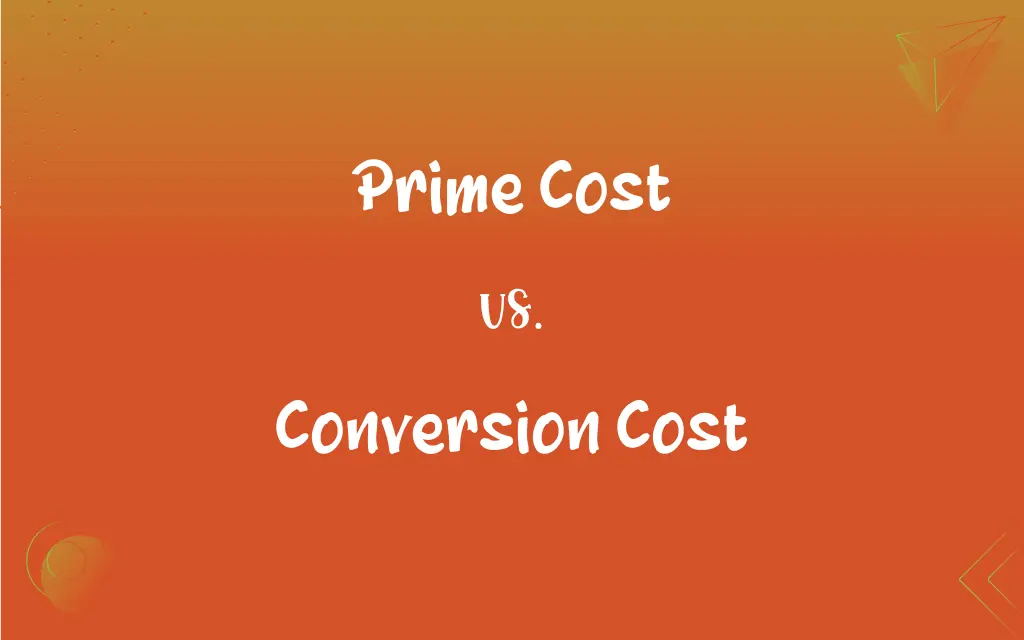Prime Cost vs. Conversion Cost: What's the Difference?
Edited by Aimie Carlson || By Janet White || Published on December 3, 2023
Prime cost is the total cost of raw materials and labor directly involved in production, while conversion cost is the total cost of labor and overhead required to convert raw materials into finished products.

Key Differences
Prime cost consists of direct materials and direct labor costs, essentially the primary and most immediate costs in manufacturing a product. Conversion cost, on the other hand, includes direct labor and manufacturing overheads, focusing on the costs associated with transforming raw materials into finished goods.
The prime cost is critical for pricing strategies as it forms the base cost of production. Conversion cost is important for understanding the efficiency and cost-effectiveness of the production process.
In prime cost, direct materials are the major component, reflecting the raw materials' expenses. In conversion cost, the emphasis is on both labor costs and overheads like factory rent, utilities, and equipment depreciation.
Prime cost is often used to calculate the gross profit margin by subtracting it from sales revenue. Conversion cost is key to evaluate the overall operational efficiency of a manufacturing process.
Prime cost is a simpler calculation, focusing on two main elements. Conversion cost requires a more comprehensive analysis of various overhead expenses in addition to direct labor.
ADVERTISEMENT
Comparison Chart
Components
Direct materials and direct labor
Direct labor and manufacturing overheads
Focus in Production
Base cost of production
Transformation of raw materials into finished goods
Major Component
Direct materials
Combination of labor and overheads
Usage in Financial Analysis
Pricing strategies and gross profit calculation
Operational efficiency and cost-effectiveness
Complexity
Relatively simple calculation
More comprehensive, including various overheads
ADVERTISEMENT
Prime Cost and Conversion Cost Definitions
Prime Cost
The sum of direct materials and direct labor costs in production.
The prime cost of the garment included the fabric and the tailor's work.
Conversion Cost
Total cost involved in converting raw materials into finished goods.
We reduced the conversion cost by optimizing our production process.
Prime Cost
Aggregate cost of labor and materials for production.
The prime cost helped determine the profitability of each product.
Conversion Cost
The combination of direct labor and overhead costs in manufacturing.
The conversion cost for the electronics included assembly labor and factory utilities.
Prime Cost
Base cost for manufacturing a product.
Calculating the prime cost is crucial for setting the right selling price.
Conversion Cost
Expenses beyond material costs in product manufacturing.
Our conversion cost analysis revealed high expenses in machinery maintenance.
Prime Cost
Direct expenses related to the production of goods.
The furniture's prime cost included wood and the carpenter's fee.
Conversion Cost
Sum of labor and additional costs in production.
The conversion cost accounted for a significant portion of our budget.
Prime Cost
Initial expenditure in creating a product.
Our prime cost analysis helps in budget allocation for new products.
Conversion Cost
Overheads and labor costs in the manufacturing process.
To lower the conversion cost, we automated some parts of our manufacturing line.
FAQs
Why is prime cost important?
It helps businesses understand the direct costs associated with production.
Is prime cost the same as variable cost?
Not exactly; variable costs can include more than just direct materials and labor.
Is prime cost used in accounting?
Yes, it's a critical accounting term, particularly in cost and management accounting.
How does prime cost impact pricing?
It helps determine the minimum price at which a product can be profitably sold.
How is prime cost calculated?
By adding the costs of direct materials and direct labor.
How is conversion cost different from prime cost?
Conversion cost includes manufacturing overhead in addition to direct labor, while prime cost does not.
What is prime cost?
Prime cost is the direct costs of manufacturing, including direct materials and direct labor.
Why is conversion cost important?
It helps in analyzing the efficiency and cost control in the production process.
Is prime cost relevant for all businesses?
It's most relevant for manufacturing and production-based businesses.
Does prime cost include overhead?
No, it excludes indirect costs like manufacturing overhead.
Does conversion cost include materials?
No, it focuses on labor and overhead costs.
Can prime cost vary?
Yes, it can vary based on changes in material costs or labor wages.
Can prime cost be reduced?
Yes, by optimizing material costs and labor efficiency.
What is conversion cost?
Conversion cost is the cost incurred to convert raw materials into finished goods, including direct labor and manufacturing overhead.
Is conversion cost relevant for service industries?
It's less relevant since service industries typically have different cost structures.
Can conversion cost impact profitability?
Absolutely. Efficient management of conversion costs can significantly impact overall profitability.
How is conversion cost calculated?
By adding direct labor costs to manufacturing overhead costs.
Can conversion costs vary by industry?
Yes, depending on the labor intensity and overheads of the industry.
Is conversion cost a fixed or variable cost?
It includes both variable and fixed components.
How do businesses use conversion cost data?
For pricing, budgeting, and assessing production efficiency.
About Author
Written by
Janet WhiteJanet White has been an esteemed writer and blogger for Difference Wiki. Holding a Master's degree in Science and Medical Journalism from the prestigious Boston University, she has consistently demonstrated her expertise and passion for her field. When she's not immersed in her work, Janet relishes her time exercising, delving into a good book, and cherishing moments with friends and family.
Edited by
Aimie CarlsonAimie Carlson, holding a master's degree in English literature, is a fervent English language enthusiast. She lends her writing talents to Difference Wiki, a prominent website that specializes in comparisons, offering readers insightful analyses that both captivate and inform.






































































